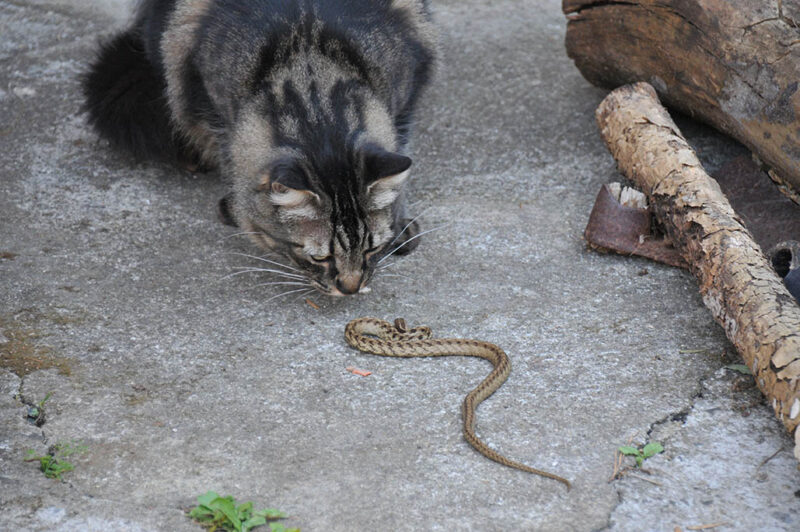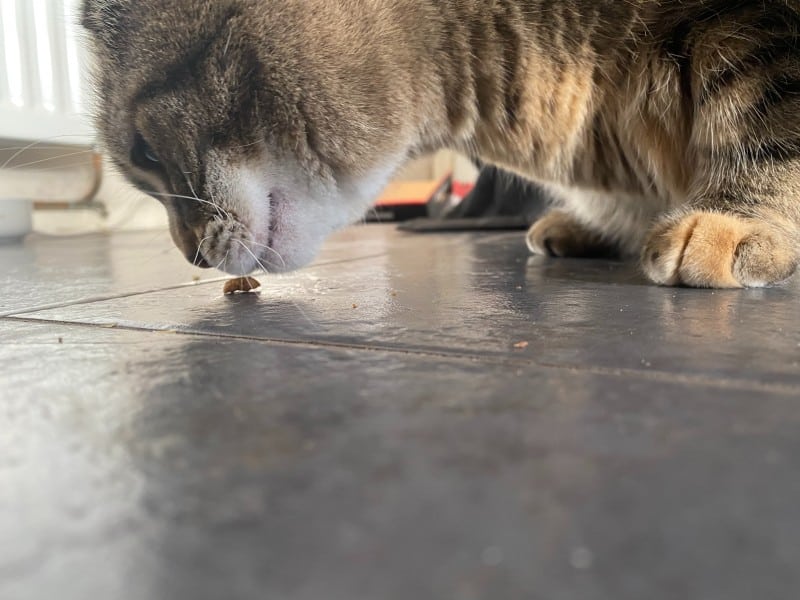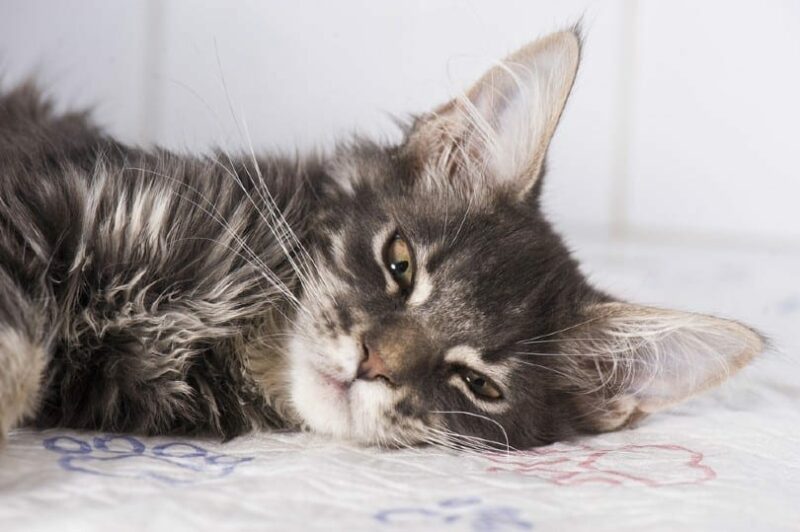If you’ve found yourself in this situation, you’re probably already aware that this is going to be tricky. Introducing cats of any disposition can be difficult to navigate, and when you’ve got some cattitude in the mix, things can get more than a little bit spicy.
In this article, we will try to unravel this dilemma into manageable steps that can hopefully lead to a relatively calm solution.

What to Consider Before You Start
Before we really get into the details, there is one thing to address: Do you need to do this? Obviously, there are situations, like the merging of two households, where we need to find a solution to introducing cats that may not wish to be introduced. Sometimes, however, we find ourselves feeling obligated or guilted into taking in a cat, and if the result is likely to be a lot of stress for both you and the cats, it is worth looking into other options.
However, sometimes we do need to find a way for unacquainted felines to co-exist, so let’s look at some helpful hacks and serious solutions.
Phase One: Preparation (Set Yourself Up to Win)
The main thing that makes this sort of situation more stressful is rushing and panicking. We’ve compiled a list of equipment and instructions to get in place before the new arrival. One part of getting ready for this process is being prepared for it not to work, but by following these steps, you can maximize your chances of success. These are all things that will work best when set up beforehand, rather than after the arrival of the new cat, but that doesn’t mean they cannot be implemented if the cat has already arrived.
1. Health Checks
Each cat should have a health check with a vet to make sure they are both fit, healthy, and up to date with vaccinations and anti-parasite treatments. Any pre-existing illnesses or injuries can have a huge impact on how these introductions go. It is also a good idea to talk to your vet and see if they have any additional advice.
If you need to speak with a vet but can't get to one, head over to PangoVet. It's an online service where you can talk to a vet online and get the advice you need for your pet — all at an affordable price!

2. Pheromone Diffusers
Pheromone diffusers are designed specifically for these sorts of situations. By emitting a pheromone to mimic the one produced by a mother cat, it helps to override scents associated with fear or hostility with one that generates feelings of calm and contentment.
To get the best results, have the diffuser plugged in and working for around 7 days before introducing the cats. Place the diffuser in a communal area, but you can also have multiple diffusers and allocate one to each cat’s “zone” (more on that later).
3. Calming Spray
You might be thinking this is the same as the pheromones, but this is another way to reduce stress and anxiety using different pathways. A product like Pet Remedy uses natural ingredients to trigger the GABA pathway in the brain, which is the body’s own internal calming mechanism. It also comes as a diffuser, but if we are using it alongside a pheromone product, the spray is a better option. It can be used on bedding, blankets, scratching posts, furniture, and carpets.

4. Cat Trees
You might already have one, and unless it is new, get rid of it (sorry). You need something with multiple levels and resting spots, and it needs to not smell like either cat yet. Position it in a communal area, like a lounge room or TV room, and spray it with a generous amount of the calming spray.
5. Separate Zones
This will obviously depend on the size of your home, but you want to aim for each cat to have a room (even if one of those rooms is a bathroom or laundry room) that they can retreat to, preferably with a shared zone separating them. For example, two rooms that both come off a communal area where the brand-new cat tree is positioned. This allows each cat to be separated if needed, but also gives them the chance to meet in a buffer zone, rather than forcing them into confrontation.
Place each cat’s food, water, and litter box in their own zone (but not too close together), and also provide a water source, litter box, and a couple of food bowls in the shared zone as well.
6. A Choice of Bedding Options
A selection of bedding options in both the shared and separate zones will ensure that each cat can feel comfortable no matter where they’re at in the house.

7. Enzymatic Cleaning Spray
There’s a good chance that one or both cats might take to scent marking, so it’s good to have the right product to hand. Enzymatic cleaners work well, as they break down the urine proteins, making the cats less inclined to keep urinating on that spot. They also don’t contain chemicals like ammonia, which can be irritant.
8. Invest in an Open-Top Cat Carrier
Once again preparing for the worst, if you need to contain an aggressive cat, it is important to do so safely. A carrier that is rigid and has a top that can be opened all the way back or removed is ideal for ensnaring a snarling kitty. You can place the open top of the carrier over the cat without having to handle them. You can then cover the carrier with a towel or blanket pre-loaded with some calming spray and place something heavy over the top to stop them from escaping the carrier.
If you need to transport them, give the cat some time to settle before carefully maneuvering the carrier to be right side up and quickly securing the lid in place.
9. Take a Deep Breath and Get Ready for Phase Two
Animals are very sensitive to our emotions, so if you are feeling really anxious about the introduction, the cats will pick up on this. Try to get into a casual, relaxed head space before entering phase two.

Phase Two: The Introductions
Now that you have set the scene, hopefully you are feeling cool, calm, collected, and ready for anything. Many people will advise keeping the cats in separate rooms for at least a few days, even a week, before allowing them to interact. The trouble with this is that it tends to build tension; the cats are completely aware of each other but are unable to properly assess one another.
1. Bring in the New Cat
To begin, take each cat into their respective zone. Allow the newly arrived cat some time to explore their room and discover all the good hiding spots, the beds, the toilet, etc. You can offer them some food, but don’t be concerned if they are not interested at this point in time. Wait until they reach a point where they are either settled and calm or focused on the door and want to see what’s out there.

2. Allow the New Cat to Explore
Open the door to the new cat’s room just wide enough for them to come out, and make sure it doesn’t close behind them—they need to be able to freely get back to that room. Allow them to have a look around the communal area for half an hour or so; again, until they settle or are interested in the door to the other zone. By this stage, the tension and anticipation are likely building behind door number two.
3. Keep Calm and Allow the Other Cat to Enter
Open the door with the other cat, the same as you did with the other one. If the new cat is hovering outside that door, steer them away for now. We don’t want to force a confrontation right away.
There may be growling, snarling, yowling, and hissing. This is okay, and, in fact, it needs to happen. Remain calm but stay close in case you do need to intervene. Sometimes there is a silent standoff with neither cat knowing what to do. This part is the most unpredictable.
If a physical fight occurs, break it up with a loud noise, a clap, or, if needed, a glass of water. Resist the urge to lock them both away. All this will do is delay things. If they try to fight again, then it’s time to separate them and allow them a few hours to unwind.
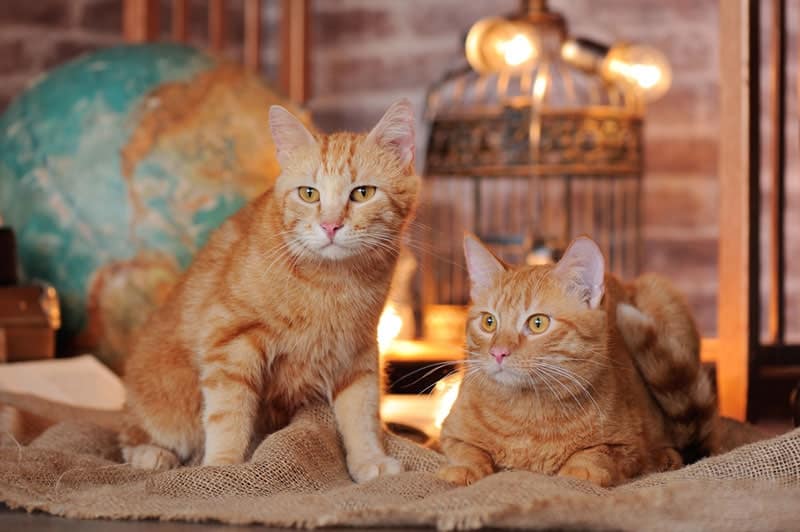
4. Assess, Address, and Adjust
This all depends entirely on the outcome of the previous step. Things might be going well, and you can really relax a bit and allow the cats to find their way around this new situation. Even if this is the case, it is sensible to contain the cats in their respective zones overnight for at least the first few days in case they decide to work out their differences at 3 AM.
If they are determined to attack one another, we need to adjust our expectations and try “through the door” interactions for a while. This is just where you keep one cat confined in a room while one sniffs the other’s scent through the door, and then you switch and allow the other to do the sniffing. Although this type of introduction can delay progress somewhat, it is also safer.
If a high level of conflict persists for more than 3–4 days, talk to your vet about adding some medication to help with the adjustment. There are some anti-anxiety medications that could help with the transition.
Even if both cats coexist peacefully, it is likely that there will still be the odd argument. It is important for them to establish their relationship, and a bit of conflict is normal in the beginning. Provided they aren’t at risk of causing each other serious injury, it is far better to allow them to sort out their differences.
5. Respect Their Decisions
If there is one thing we know about cats, it’s that you cannot force them to do anything. If, despite all preparations and precautions, these cats will not coexist peacefully, you may need to think about another solution—perhaps finding a friend or family member who could take one in, allowing you to still see them.
It is common for cats to “agree to disagree” and coincide peacefully but not affectionately. If they are not fighting, hiding, overgrooming, or urinating outside the litterbox and both cats seem to be content, accept this as a success. If, however, they are exhibiting any of those behaviors, it would be sensible to get input from your vet. Again, some medications may help to reduce stress and anxiety if the pheromones and calming sprays are not enough.
You might find that, in the best-case scenario, the cats get along well—fantastic! But you might also find that it has changed the way your cat behaves around you. Depending on the dynamic the cats have established, that may include their interactions with you, as it is quite common for one cat to claim ownership of the human. Again, this is something you need to accept. If your cats have found a calm, peaceful, and hopefully happy way to live together, interfering with the dynamic they have created can lead to more friction.
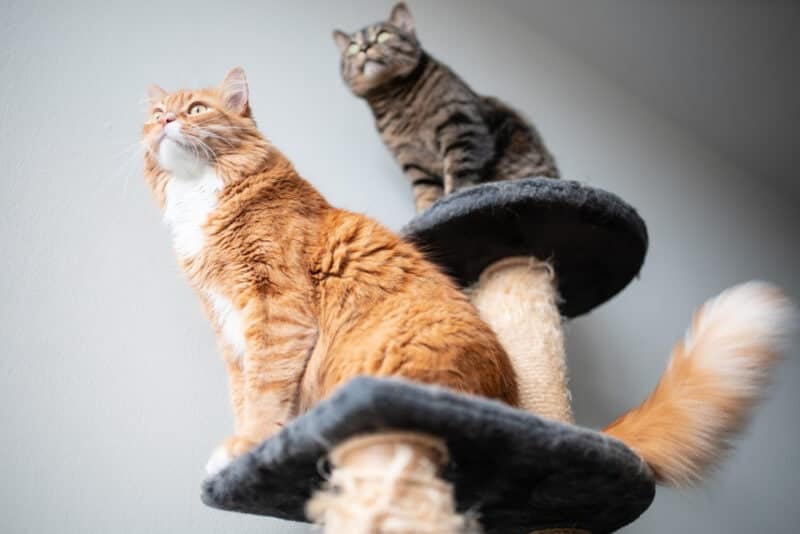
6. Don’t Get Rid of the Diffusers or Sprays
Not yet anyway. Even if things are going really well, you do not want to get rid of the tools that likely helped get you there. You can start reducing the use of the calming sprays first, and if there is no deterioration in behavior, try switching the diffusers off during the day for a few weeks before stopping altogether. You may find that things are calmer with the diffusers in use, and that is fine! Many homes use them permanently, which brings us to our final step.
7. Do What Works for You
Hopefully, these tips and techniques will have helped make a challenging situation a little easier, but every cat and every situation is unique, and in the end, you need to do what works for you, your family, and your pets.

Conclusion
It can be really tricky to introduce cats to one another. There are times when it all goes smoothly and all the preparation pays off, and we hope that is the case for you. With luck, patience, and perseverance, hopefully, your blended feline family can live together in harmony. Don’t forget to reach out to your vet if you have any questions or concerns or if you just need some advice.
See Also:
- How to Introduce Your Cat to a New Cat: 8 Vet Approved Tips & Advice
- How to Introduce a Third Cat to Your Home (10 Great Tips)
Featured Image Credit: Pixabay




